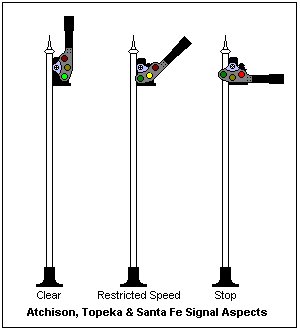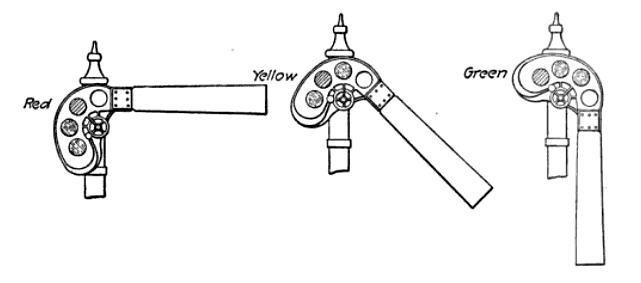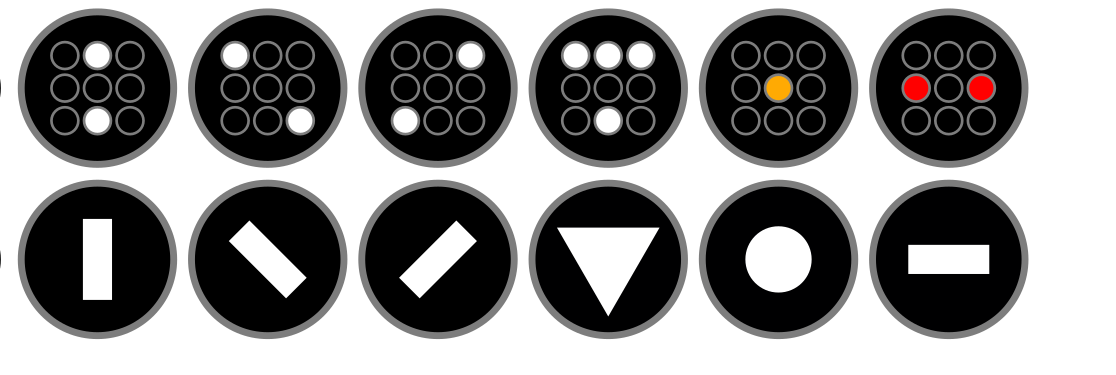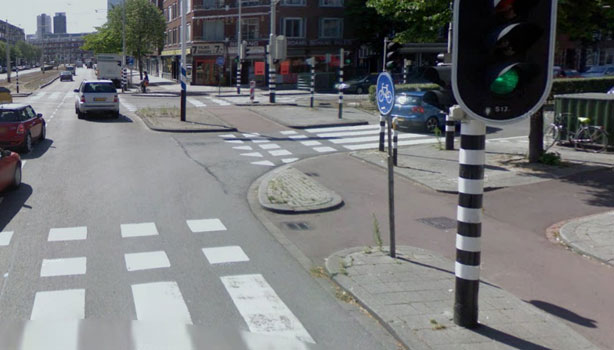BurlOak
Senior Member
If I would have designed the old system, red and green would be reversed. If the system fails, gravity would lower the arm to be more or less vertical. It is safer to make vertical a stop and horizontal a go.
There's also the Wigwag:In the early days of the railway, they used semaphore signals to indicate how trains should proceed or not. These days, they switched over to using traffic signals similar to what we have at street intersections.
That's fine, when the trains run on private right-of-ways, away from motor traffic. Not so fine where the signals could get mixed up.


Note how the position of the semaphore arm are similar to transit signals used in other counties.





There's also the Wigwag:

Wouldn't it be better if we replace this sign
[STOP HERE ON RED]
with a nearside traffic signal?
Right where the motor vehicles should actually be stopping?
The near side signals you normally see are to provide an extra signal in areas where visibility of the far side signals is reduced - typically at hills, turns that lead to intersections, etc.We already do that for signals where the stopping location is unusually far back.
View attachment 85585
Harbourfront Centre at Queens Quay northbound. Image from Streetview
In locations such as the Netherlands where signals are only on the near side, they are extremely effective at enforcing correct stopping locations. But in locations where they are used in addition to far-side signals, they are only marginally effective. If we were starting from scratch, I'd probably support near-side signals but at this point it's not worth switching.

When I visited Manhattan, almost everyone there jaywalked across the east-west streets anyways (if there is no incoming traffic).
Some of the crosswalk buttons are just placebo at best.
When people find out I have a working knowledge of traffic signals, this is often the first question they ask. “When I press the button, does it actually do anything to the signal timing?” The short answer is: sometimes. Because there’s more to pedestrian buttons than just getting a walk light to cross the street.
There’s two parts t0 the answer here, which are:
1. There are some pedestrian crossings where someone needs to press a button for the walk light to be displayed, and other crossings where there is no need for anyone to press a button,
2. Pedestrian buttons are being installed at all pedestrian crossings, whether or not those buttons actually have an effect on signal timing.
Why doesn’t the walk light just come on all the time?
At a typical intersection between a main street and a side street, the pedestrian signal along the main street defaults to walk, so it doesn’t matter whether or not anyone presses the button. But to get a walk signal along the side street, you actually need to press the button. If there are cars waiting and nobody presses the pedestrian button, the vehicle signal will display Green but the pedestrian signal will remain in Don’t Walk.
If the walk signal came on every time the light turned green, it could cause unnecessary delay to perpendicular traffic in the situation when there are only a few cars and no pedestrians. For example, a pedestrian crossing across a 7-lane road might require a minimum of 28 seconds of green (7 seconds of Walk and 21 seconds of Flashing Don’t Walk). But in the absence of a pedestrian call, the green duration for side streets can respond in real-time to the actual amount of vehicle demand, so if there are only a couple cars waiting, the green light could be as short as 7 seconds. Varying the green duration based on side street vehicle demand means that people travelling along the main street aren’t kept waiting any longer than needed*.
It’s for this same reason that often pedestrian crossings along a main road will displayWalk regardless of whether anyone presses the button. Due to the anticipated volume of vehicle traffic, the signal is going to provide more than enough time to walk across the side street anyway, so the pedestrian signal might as well display Walk even if there wasn’t anyone waiting to cross at the start of the green. Displaying Walk as much as possible avoids any unnecessary delay for people who show up after the light has already changed to green.
Why are all crossings getting pedestrian buttons?
Eventually, all pedestrian crossings in the City of Toronto will have pedestrian buttons, regardless of whether the pedestrian button would have any effect on signal timing. The same is also true in many other jurisdictions across the province. This is because buttons are the way of activating the Accessible Pedestrian Signal (APS) audible tones, which are gradually being installed at all traffic signals.
Originally, APS was on whenever the walk light was on, so it didn’t need any buttons to operate. But after a number of noise complaints from nearby residents, the current system was introduced, where the APS sounds would only be played when someone presses and holds the pedestrian button for 3 seconds (at which point the button makes a tick noise to indicate the APS call was received).
Making sense of pedestrian buttons
The problem with having buttons that don’t affect signal timing is that when some people discover that there are pedestrian buttons which have no effect on signal timing, they come to the conclusion that all pedestrian buttons are placebos. This is a problem, because there actually are crossings where one does need to press the button to get a walk light.
The solution to this problem is very simple. Each pedestrian button should indicate whether one needs to press it to get a walk signal, or if it’s only there to call the APS sounds. Variations of this system are implemented in a number of jurisdictions in Ontario. In the City of Ottawa, buttons which actually call the pedestrian phase have a sign saying “press this button”, while buttons which only call APS sounds have no sign.
In Ottawa, the buttons without signs are only there to activate APS sounds
But I found that system to not be sufficiently reassuring. Upon encountering a button with no sign, I wouldn’t be certain if meant that I didn’t need to press the button or if the sign had simply fallen off. So I always pressed the button to be sure.
My favourite solution is the one used in Waterloo Region, where buttons which only exist to activate APS sounds have the symbol of a person with a white cane.
“This button only activates the APS sounds”
“You need to push this button to get a Walklight”
This labeling system is a clean and simple way of indicating what pedestrian buttons do (or don’t do), putting an end to the myth of the placebo pedestrian button.
CITY News video on pedestrian signals: http://bcove.me/anj9oi6u




